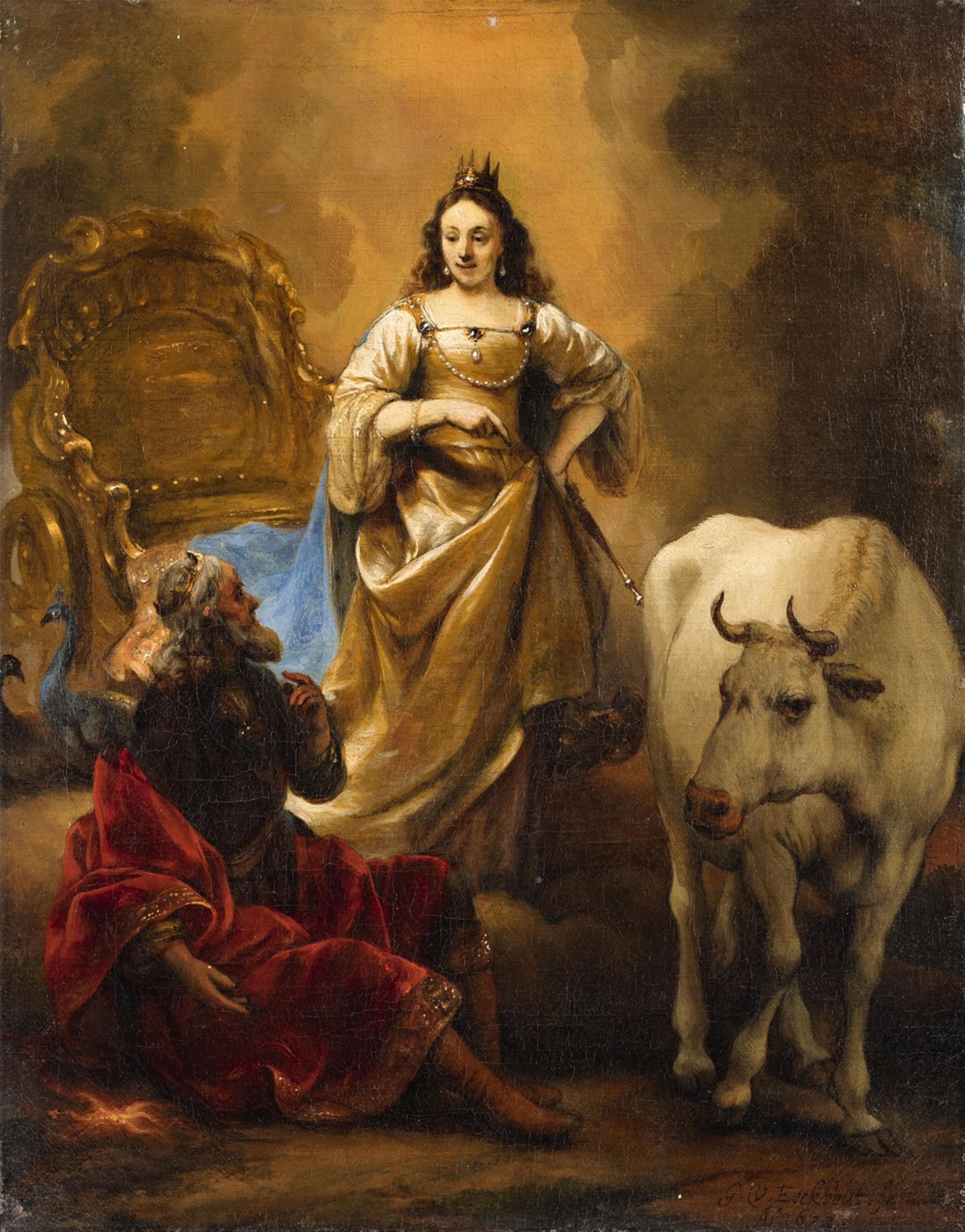Gerbrand van den Eeckhout
Juno, Jupiter and Io
Oil on canvas. 40 x 31 cm.
Signed and dated lower right: G. V. Eeckhout fc./1672.
This signed and dated painting by Gerbrand van den Eeckhout depicts one of the many love affairs of Jupiter, told in Ovid's Metamorphosis (I, 612-616). The story, in short, is as follows: Jupiter transforms the beautiful Io, daughter of King Inachos, into a cow to conceal his liaison with her from his jealous wife Juno. However, Juno sees through this trick and demands the cow as a gift, forcing Jupiter to give in to her request in order to avoid suspicion. Juno then has Io, still in the form of a cow, watched by the 100 eyed Argus Panoptos whilst Jupiter in turn sends Hermes, the messenger of the Gods, to free his paramour. Hermes succeeds in his quest by putting the giant Argus to sleep with music played on his flute. The legend tells that since then the eyes of Argus decorate the feathers of peacocks.
In his subtly humorous work, Gerbrand van den Eeckhout depicts the moment when Juno requests the cow as a present. She has dismounted from her chariot and stands in a matronly pose, pointing to the cow and looking down mischievously at Jupiter, who sits on the ground before her. Slightly incongruously to her manner, Juno wears a small crown upon her head, and is visibly delighted by the discomfort that her ploy is causing her husband. The recumbent figure of Jupiter is devoid of all divine qualities, and appears helpless and nonplussed that the situation is evading his control. Io is shown watching the scene and she is depicted, as in Ovid's description, as being beautiful to look upon even as a cow. The artist has arranged the figures in a triangular composition with Juno in the centre. The image is dominated by a palette of warm gold and ochre tones which can also be found in van den Eeckhout's other works of this period (cf. for example “Jacob's Dream” from the same year; Sumowski, op. cit., no. 481).
The present work forms a small cycle together with two other paintings showing “Mercury and Argus” and “Juno Receiving the Head of Argus from Mercury”, which were both painted in 1672 (Sumowski, op. cit., p. 743-744). The painting demonstrates two of the main characteristics of Gerbrand van den Eeckhout's oeuvre. For one, it shows that his small and mid-format works were conceived for a learned audience who were able to interpret their, often somewhat obscure, mythological subjects, but it also displays van den Eeckhout's stylistic debt to Rembrandt. According to Arnold Houbraken, van den Eeckhout was the great master's favourite pupil, and Sumowski points out that he has based his Juno on Rembrandt's famous depiction of the Goddess now kept in the Hammer Museum in Los Angeles (painted ca. 1662-65).
Provenance
Collection of M. Damery. - Kunsthandlung Steinmeyer, Lucerne. - Dr. Wassermann, Berlin. - Auctioned in Berlin, 27.2.1935, lot 215. - Dr. Florian Klöckner, Duisburg. - Collection of Dr. Hans Pinckernelle, Hamburg. - 701th Lempertz auction, Cologne, 14.5.1994, lot 385. - Private collection, South Germany.
Literature
R. Roy: Studien zu Gerbrand van den Eeckhout. Diss. Wien 1972, Wien 1972, p. 112, p. 221, no. 72. - Werner Sumowski: Gemälde der Rembrandt-Schüler. Landau 1983, vol. 2, p. 743, no. 482. - Eric Jan Sluiter: De "Heydense Fabulen" in Noordnederlande schilderkunst, cirka 1590 - 1670. Diss. Leiden. Leiden 1986, p. 55, p. 394, 550-10. - Hoogsteder & Hoogesteder: Rembrandt´s Academy. Den Haag/Zwolle 1992, p. 134-137.
Exhibitions
Rembrandt´s Academy, Hoogsteder & Hoogsteder, Den Haag, 1992.

